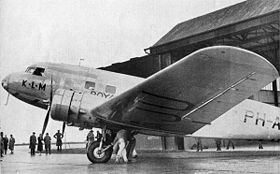Airplane crash of the KLM Douglas DC-2 "Uiver"
| Airplane crash of the KLM Douglas DC-2 "Uiver" | |
|---|---|
|
The crashed plane |
|
| Accident summary | |
| Accident type | unexplained |
| place | near Rutbah Wells , Iraq |
| date | December 20, 1934 |
| Fatalities | 7th |
| Aircraft | |
| Aircraft type | Douglas DC-2 |
| operator | KLM |
| Mark | PH-AJU |
| Departure airport | Amsterdam Schiphol Airport , Netherlands |
| Destination airport |
Tjililitan Airport , Batavia , Dutch East Indies |
| Passengers | 3 |
| crew | 4th |
| Lists of aviation accidents | |
The crash of the name "Uiver" baptized Douglas DC-2 of the Dutch airline KLM occurred on December 20, 1934 during a severe thunderstorm with heavy rains over the Syrian / Iraqi desert near Rutbah Wells (Iraq). All seven inmates were killed. The cause of the accident remained unclear. It was the first total loss of this type of aircraft.
plane
The crashed Douglas DC-2 "Uiver" with the registration number PH-AJU was the 18th machine of this type with the serial number 1317 from the Douglas Aircraft Company on August 16, 1934 in individual parts to the manufacturer Fokker and finished by them in the Netherlands been. She had two Wright Cyclone SGR 1820-F2 piston engines with 750 hp each. The aircraft had a cruising speed of 290 km / h, a maximum take-off weight of 8.4 t and a range of 1750 km.
This DC-2 had its finest hour in October 1934, when it took second place for KLM in the MacRobertson air race from Mildenhall ( England ) to Melbourne ( Australia ), and also won the handicap classification. The "Uiver" covered the distance in a time of 90 hours and 13 minutes. What was remarkable was the fact that, despite an emergency landing in Albury (Australia) in the meantime , during which the cargo had to be unloaded, it was only subject to a De Havilland DH.88 Comet specially designed for this race .
Flight history
In the early morning of December 19, 1934, the plane took off from Schiphol-Amsterdam Airport on an extra Christmas mail flight to Batavia . The intention was to break the record Christmas flight of the Fokker F.VIII "Pelican" of December 1933 with this flight . In addition to the four-person crew, there were three passengers and around 350 kg of airmail on board. The route to Batavia was completed with intermediate stops, including in Marseille , Rome , Athens and Cairo .
At 21:30 UTC (23:30 local time), the "Uiver" took off from Cairo for an onward flight to the east. At this point, the crew had not yet decided whether the next stopover would be in Gaza , Rutbah Wells or Baghdad . The pilots decided against landing in Gaza and continued the flight to Rutbah Wells. At 00:11 UTC, the crew reported for the last time to the Royal Air Force station there . Half an hour later, the plane was heard by workers at the H.3 pumping station, which was located on the oil pipeline running from Kirkuk to Haifa . Then the machine disappeared.
Bad weather prevented an immediate search for the aircraft. On December 21, an RAF pilot discovered the burned-out wreck about 16 km south of Rutbah Wells in the desert. The degree of destruction indicated that the machine had hit the ground at high speed. In view of the condition of the instruments, it was initially concluded that lightning could have been the cause of the accident. This was later revoked. The Dutch government's investigation report was not published.
Some facts became known: The cause of the accident was neither a lightning strike, a fire on board nor a technical problem. The Douglas DC-2 hit the right bank with the aircraft nose slightly lowered , the engines running and the landing gear retracted. The wreck was found in the opposite direction to the planned flight path. This seemed to indicate that the crew had changed course by 180 degrees to avoid the storm. Another explanation would be that the machine went into a spin while flying through the thunderstorm , crashed in an uncontrolled manner and hit in the opposite direction. Due to its relatively small vertical stabilizer , the Douglas DC-2 had poor lateral stability and tended to yaw . Corresponding flight behavior had occurred several times with this type. It was also assumed that the pilots were overtired at the time of the accident.

